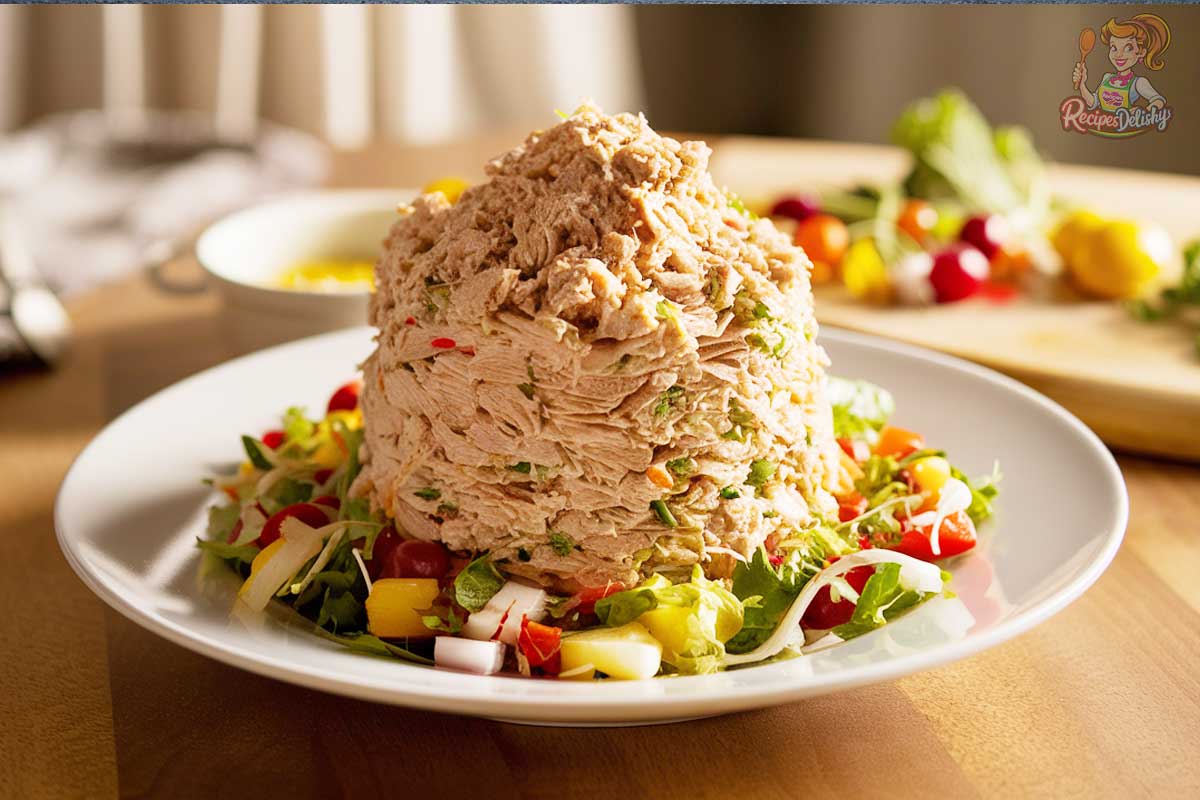Introduction to Tuna Salad
Tuna salad has been a staple in kitchens across America for over a century, known for its simplicity and versatility. Typically made with canned tuna, mayonnaise, and a variety of add-ins like celery or onions, this dish can be served on its own, as a sandwich filler, or even as a salad topping.
What is Tuna Salad?
At its core, tuna salad consists mainly of canned tuna mixed with mayonnaise and other ingredients to enhance its flavor and texture. Variants might include ingredients like mustard, chopped vegetables, herbs, and spices to suit personal tastes. Tuna, whether albacore, yellowfin, or skipjack, is packed with protein and nutrients, making it an excellent choice for a quick meal.
Why Tuna Salad?
Besides being downright delicious, tuna salad is revered for its convenience and nutritional benefits. It’s a fantastic source of omega-3 fatty acids, known for improving heart health and reducing inflammation. Plus, it’s incredibly versatile. Whether you’re looking for a low-carb dinner option or a satisfying lunch, tuna salad fits the bill perfectly.
This introduction sets the stage for understanding how long tuna salad in fridge can safely last, helping you enjoy this dish in its best form every time. Stay tuned as we dive into the specifics of tuna salad’s shelf life in the next section!
Shelf Life of Tuna Salad
When it comes to refrigerated storage, not all salads are created equal. Tuna salad, with its protein-rich canned tuna and creamy mayonnaise base, follows specific guidelines to ensure it remains safe and enjoyable to eat.
How Long Does Tuna Salad Last in the Fridge?
According to both the USDA and FoodSafety.gov, tuna salad is typically safe to consume for 3-4 days when stored properly in the refrigerator. This timeline is consistent for most protein-based salads, such as chicken or egg salad, making it a reliable guideline for your meal planning.
Factors Affecting Shelf Life
The longevity of tuna salad in your fridge can depend on several factors:
- Quality of Ingredients: Freshness of the ingredients at the time of making the salad can significantly influence its shelf life. Older ingredients may spoil faster, reducing the overall freshness period of the salad.
- Storage Conditions: The temperature of your fridge should be consistently at or below 40°F (4°C). Any fluctuations can shorten the life of your tuna salad.
- Preparation Techniques: How the salad is prepared and handled can also impact its shelf life. Cross-contamination during preparation, especially with utensils or surfaces that have touched raw meat, can introduce bacteria that spoil the salad quicker.
By understanding these factors, you can ensure that your tuna salad remains fresh and tasty within the recommended storage period. Next, we’ll explore the best practices for storing tuna salad to maximize its shelf life.
Storage Tips
Proper storage is critical to extending the life of your tuna salad in the refrigerator. Here, we dive into the best practices that help maintain its freshness and safety.
Proper Storage Techniques
The first rule of thumb for storing tuna salad is to refrigerate it within two hours of preparation. This is especially important on warmer days where room temperatures can accelerate the growth of bacteria.
- Use of Appropriate Containers: Always store tuna salad in airtight containers to avoid exposure to air, which can increase the risk of contamination and spoilage. Glass containers are preferred over plastic, as they are less likely to harbor smells and are generally easier to clean thoroughly.
- Refrigerator Placement: To maintain optimal freshness, place your tuna salad in the coldest part of the refrigerator, usually at the back, away from the door. This area experiences the least temperature fluctuations, which is crucial for preservation.
What Not to Do: Common Storage Mistakes
Avoid these common pitfalls to ensure your tuna salad stays fresh:
Leaving Tuna Salad at Room Temperature
Never leave tuna salad out for more than two hours. If the ambient temperature is above 90°F (32°C), reduce this time to one hour.
Frequent Container Opening
Every time you open the container, you expose the salad to temperature changes and contaminants. Try to minimize how often you open the storage container and always use clean utensils to serve or stir the salad.
By following these storage tips, you can significantly extend the freshness and safety of your tuna salad. Now, let’s consider how different ingredients might affect the shelf life of your salad, ensuring you enjoy it in its best state every time.
Impact of Ingredients on Shelf Life
The ingredients you choose for your tuna salad not only impact its flavor but also its shelf life. Understanding which ingredients preserve freshness and which may hasten spoilage is key to maintaining the quality of your salad.
Role of Ingredients in Shelf Life
Certain ingredients can influence how long your tuna salad remains edible in the fridge:
Mayonnaise vs. Yogurt
Tuna salads made with mayonnaise tend to last longer than those made with yogurt. Mayo’s high oil content creates a barrier that helps slow down the growth of bacteria, whereas yogurt, being more perishable, can spoil quicker.
Acidic Additions
Ingredients like lemon juice or vinegar can extend the shelf life of tuna salad by lowering the pH and creating an environment less hospitable to bacteria.
Ingredient Sensitivity
The type of ingredients mixed with the tuna also plays a critical role:
- Crunchy Vegetables: Ingredients like celery or onions add texture and flavor but also contain moisture, which can encourage bacterial growth if the salad is not stored correctly.
- Herbs and Spices: While herbs like parsley or dill enhance flavor, they need to be fresh to avoid introducing spoilage. Dry spices are generally safe and can even help preserve the salad.
By carefully selecting your ingredients and understanding their effects on the longevity of tuna salad, you can ensure it stays fresh and delicious throughout its shelf life. Next, we will explore how to identify when tuna salad has gone past its prime and should no longer be consume
Signs of Spoilage
Knowing when your tuna salad has gone bad is crucial to avoid foodborne illnesses. Here are some indicators to help you determine if it’s time to throw out your salad.
Detecting Spoiled Tuna Salad
Keep an eye out for these signs of spoilage:
- Appearance: Any visible mold or an unusual color change can indicate spoilage. If you see mold, discard the entire salad, as the toxins can spread beyond visible areas.
- Smell: A sour or unpleasant odor is a clear sign that the tuna salad is no longer good. Tuna salad should have a fresh, mild smell; anything strong or foul suggests it has spoiled.
- Texture: If the salad feels slimy or the ingredients have become overly soggy, it’s best to toss it. The texture should be creamy but not gooey.
Health Risks Associated with Spoiled Tuna Salad
Consuming spoiled tuna salad can lead to food poisoning, characterized by symptoms such as nausea, vomiting, and diarrhea. Bacteria like Salmonella or E. coli could be present if the salad is not stored or handled properly. Always err on the side of caution and discard any salad that shows signs of spoilage.
By staying vigilant and recognizing these signs, you can ensure that you enjoy your tuna salad safely. Up next, we will address some frequently asked questions to clear up any further uncertainties about storing and consuming tuna salad.
Extending Shelf Life
FAQs About How Long Tuna Salad Lasts in the Fridge
Tuna salad, while simple, often brings up several questions regarding its preparation and storage. Here are answers to some frequently asked questions to help you handle your tuna salad correctly.
Can You Freeze Tuna Salad?
While technically possible, freezing tuna salad is not recommended. The mayonnaise and vegetables in the salad can separate or become soggy upon thawing, negatively affecting the texture and flavor of the salad.
How Can You Tell if Tuna Salad is Bad?
The most immediate signs are a sour smell, visible mold, or a slimy texture. If your tuna salad exhibits any of these characteristics, it’s best to discard it to avoid the risk of foodborne illness.
Difference in Storage Guidelines Between Homemade and Store-Bought Tuna Salad
Both homemade and store-bought tuna salads should be stored in the refrigerator and consumed within 3-4 days. However, always check the use-by date on store-bought salads, as they may have been prepared days before purchase.
By understanding these FAQs, you can enhance your ability to keep your tuna salad fresh and safe to eat. Next, we’ll explore how you can extend the shelf life of your tuna salad with some effective tips.

